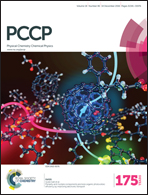Ab initio thermodynamic study of the SnO2(110) surface in an O2 and NO environment: a fundamental understanding of the gas sensing mechanism for NO and NO2
Abstract
For the purpose of elucidating the gas sensing mechanism of SnO2 for NO and NO2 gases, we determine the phase diagram of the SnO2(110) surface in contact with an O2 and NO gas environment by means of an ab initio thermodynamic method. Firstly we build a range of surface slab models of oxygen pre-adsorbed SnO2(110) surfaces using (1 × 1) and (2 × 1) surface unit cells and calculate their Gibbs free energies considering only oxygen chemical potential. The fully reduced surface containing the bridging and in-plane oxygen vacancies under oxygen-poor conditions, while the fully oxidized surface containing the bridging oxygen atom and the oxygen dimer under oxygen-rich conditions, and the stoichiometric surface in between, was proved to be most stable. Using the selected plausible NO-adsorbed surfaces, we then determine the surface phase diagram of SnO2(110) surfaces in (ΔμO, ΔμNO) space. Under NO-rich conditions, the most stable surfaces were those formed by NO adsorption on the most stable surfaces in contact with only oxygen gas. Through the analysis of electronic charge transfer and density of states during NOx adsorption on the surface, we provide a meaningful understanding about the gas sensing mechanism.


 Please wait while we load your content...
Please wait while we load your content...